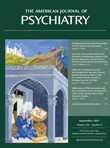To The Editor: The editorial by Sanjaya Saxena, M.D.
(1), in the March 2007 issue of the
Journal, implicates that there is enough research-based evidence to justify that compulsive hoarding constitutes a discrete entity, apart from obsessive-compulsive disorder (OCD) as such, to be placed separately in the future DSM-V classification system. The important article by Jack Samuels, Ph.D., et al.
(2), also published in the March 2007 issue of the
Journal, contains several results that cast doubts on this conclusion. First, all but six of the hoarding individuals in the cohort assessed by Dr. Samuels et al.
(2) had additional obsessions and compulsions, especially symmetry and somatic obsessions, as well as repeating, counting, and ordering compulsions
(3), indicating substantial symptom overlap with other perhaps intuitively more “typical” OCD symptom dimensions. We therefore do not agree with the authors that many of the hoarders do not have other OCD symptoms. Second, as also mentioned by Samuels et al.
(2), hoarding in itself seems to be heterogeneous. In our opinion, the “hoarding” criterion of obsessive-compulsive personality disorder, characterized by thrift, differs from the three core symptoms of clinically significant compulsive hoarding. Moreover, within groups of patients with significant compulsive hoarding, we observe clinical heterogeneity. Furthermore, hoarding can arise as a secondary condition from other disorders, such as schizophrenia, dementia, and Prader-Willi syndrome. Third, the linkage study conducted by Samuels et al.
(2) was done so on the presence of any hoarding symptom in a potentially heterogeneous group of hoarding individuals instead of a group with clinically significant compulsive hoarding. We therefore feel that their results do not add evidence with respect to the hypothesis that compulsive hoarding is an etiologically discrete phenotype from OCD. In addition, Samuels et al.
(2) noted that they found linkage peaks at a chromosome different from that reported in a previous linkage study on hoarding. Replication of these findings is needed before we can conclude that there is a special susceptibility locus for hoarding.
In summary, the points mentioned in the article by Samuels et al.
(2) suggest that evidence for hoarding as a distinctive syndrome is not very sound, since hoarding seems both phenomenologically and genetically heterogeneous, possibly with subtypes related and subtypes unrelated to OCD. Therefore, much more research on hoarding is needed
before implications for a new diagnostic classification can be made.

